The NVIDIA SHIELD Tablet Review
by Joshua Ho on July 29, 2014 9:00 AM ESTBattery Life
As always, battery life is one of the most important aspects of any mobile device, and is crucial to staying mobile. There’s not much introduction needed to this, as it’s rather well understood that more battery life is usually better. The Shield tablet features an integrated 19.75Wh battery.
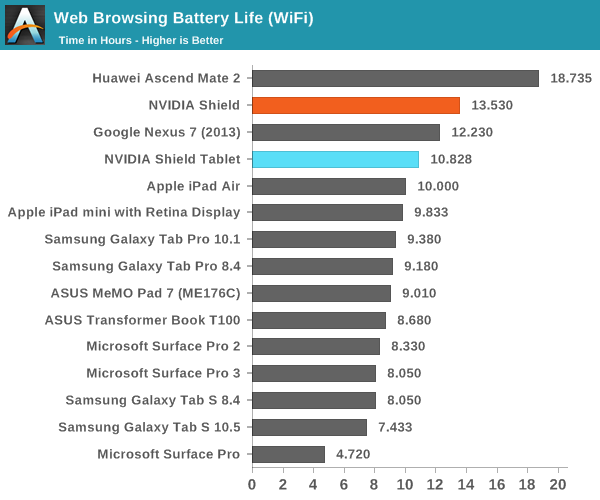
This device is a tablet first and foremost, so WiFi browsing battery life is important. In this area, the tablet does well. However, it’s a bit strange how the device performs worse than the Nexus 7 (2013). The reason why I say this is that the Tegra K1 is on a far more power efficient process (28HPm), has broadly equivalent battery capacity to screen area scaling, and should have a more power efficient display due to the reduced gamut. However, it could be that Cortex A15 just isn’t as power efficient as Krait and the silicon backplane of the display isn’t as efficient as the one in the Nexus 7.
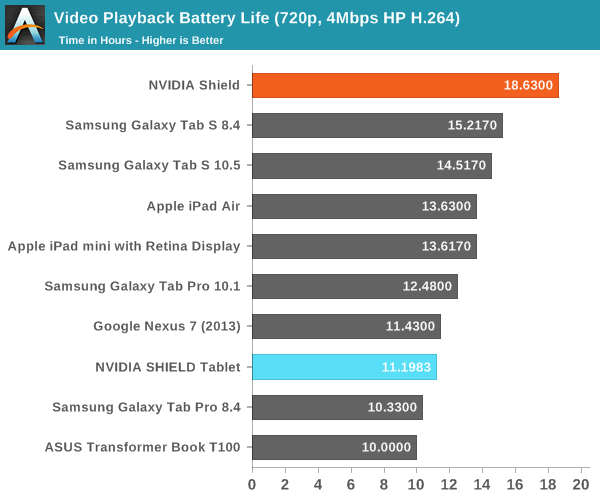
While normally web browsing tests are enough to cover the relatively low-compute use cases for smartphones, video playback is a significant use case for tablets. Here, we see that the gap between the Nexus 7 (2013) and the SHIELD Tablet narrows significantly, which can probably be attributed to the mostly display-bound nature of this test. Due to the much lower APL average of this test, we see that the Galaxy Tab S line does noticeably better in this test because their AMOLED displays mean that black-heavy content dramatically reduces power draw. This is because a black pixel in an AMOLED display is turned off and doesn't consume power, while an LCD display relies on a backlight so it isn't possible to turn off the backlight for a single pixel without turning off the entire display.

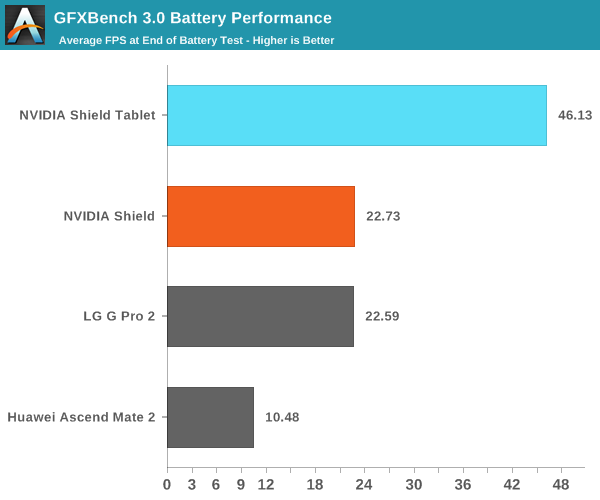
Of course, the Shield Tablet is also designed for gaming. Unfortunately, the Tegra K1 introduces quite a massive amount of dynamic range. While it’s fully possible for the Shield tablet to last 10 hours of continuous use on a single charge, running the GPU at full blast gives battery life similar to a gaming laptop. Realistically, if a game is made for Tegra K1 and truly stretches the GPU to the limit, battery life is only around two and a half hours, assuming display brightness is kept down to 200 nits. Of course, anything less intensive will do much better.
NVIDIA has also made it possible to cap the maximum frame rate and clock speed for better battery life. However, it’s quite clear in this test that the tablet isn’t capable of sustaining peak performance the way the Shield portable was, as the Shield portable sustained around 90% of the first run performance while the tablet sustained around 80% of its first run performance. The Shield Tablet also has noticeably higher skin temperatures, although this was a subjective observation.


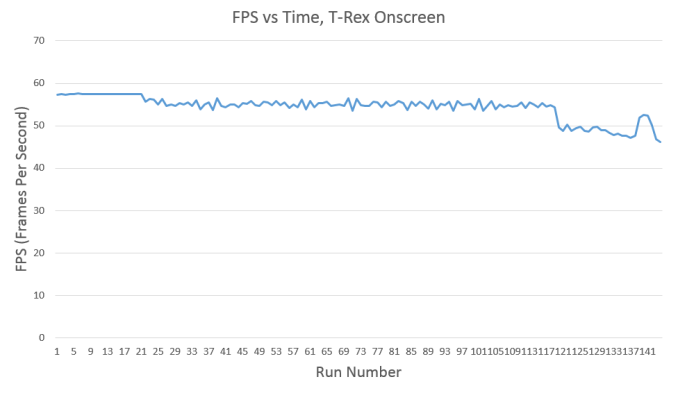
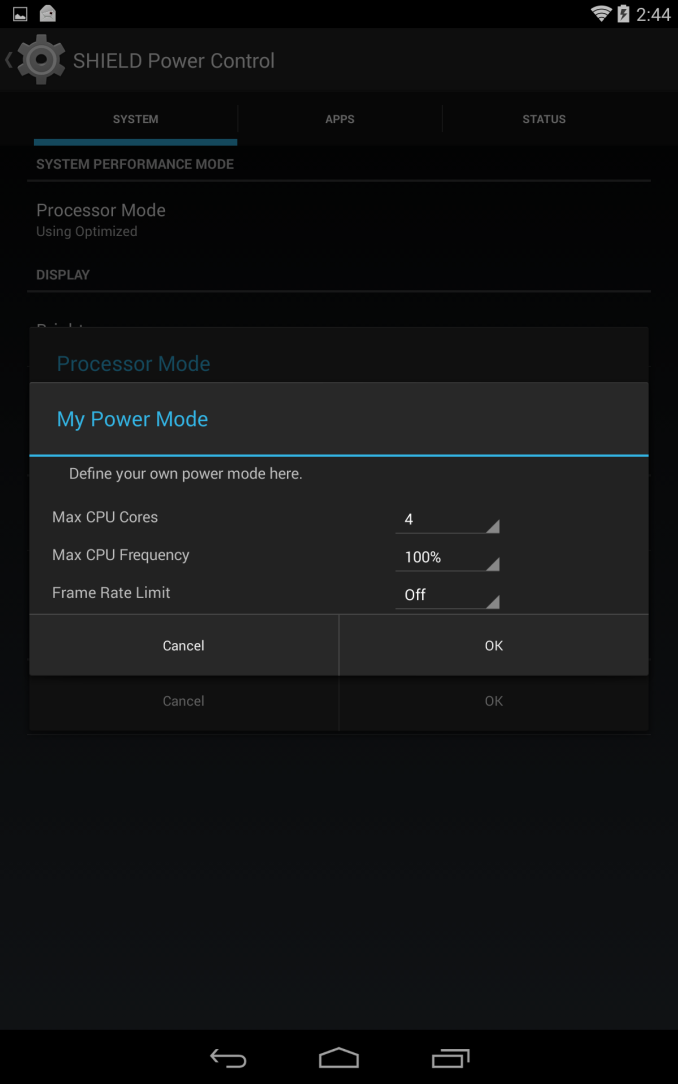
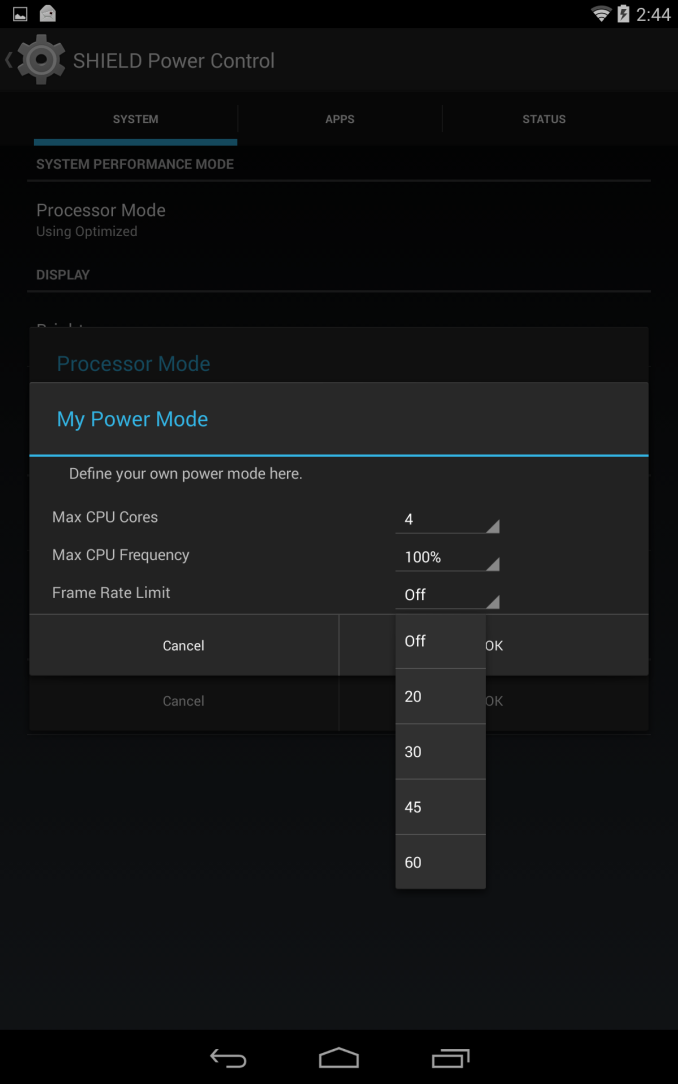








174 Comments
View All Comments
cknobman - Tuesday, July 29, 2014 - link
Thought Nvidia had a real killer here.Until I saw how crappy the screen is. On a tablet having such crappy color reproduction is just not going to cut it.
ams23 - Tuesday, July 29, 2014 - link
Overall the Shield tablet display is not bad but not great. The black levels, contrast ratio, and saturation accuracy are quite a bit better on Shield tablet compared to iPad Mini Retina. The max brightness and white point accuracy are slightly better on Shield tablet compared to iPad Mini Retina. The grayscale and GMB accuracy are quite a bit worse, however, and are the two areas that need some work.rodolfcarver - Friday, October 3, 2014 - link
I agree that it's not bad, but the truth is that most games will be just as good on some of the top tablets (http://www.consumertop.com/best-tablets/ ), and they will also be better for all other tasks. Therefore I don't see the point of the Nvidia Shield.willis936 - Tuesday, July 29, 2014 - link
You must have skipped the cpu and gpu benchmarks...ddriver - Tuesday, July 29, 2014 - link
Color accuracy is pretty much irrelevant for gaming.B3an - Tuesday, July 29, 2014 - link
Well yeah, if you're a moron.zodiacsoulmate - Tuesday, July 29, 2014 - link
that's mean... also you are wrong color accuracy is so irreverent in gaming...inighthawki - Tuesday, July 29, 2014 - link
Games already use low resolution color palettes. Textures almost never have more than 8 bits per channel (and are often compressed beyond that), and lighting calculations and sampling error is already going to produce generally "wrong" colors with respect to the real world. You're absolutely fooling yourself if you believe you will see a noticeable difference between this and a more accurate display while gaming.mkozakewich - Tuesday, July 29, 2014 - link
"Games" use an incredibly varied set of graphical abilities. Maybe first-person shooters are different, and a lot of hyper-realistic AAA games in general; but there are plenty of games that are bright or cel-shaded, and those look a lot better on a screen with rich colours.You can't just say a display is good or bad. The reason they give us all these specs is so that we can make our own choices. Someone who plays games with muted or washed-out colours can decided that it's fine, and that this works for them based on the tradeoffs it makes.
inighthawki - Tuesday, July 29, 2014 - link
I agree there are cases, typically indie games, where this is true, but this is an incredibly small subset of the game market, and also generally not the target audience of such a device. The shield seems to be targeted more at heavy gamers, especially those who wish to stream games from a high end PC in another room. These are the people who typically have many AAA titles and games where the graphics are so complex, and the amount of estimation used to compute lighting and texture quality is off from realistic values enough to not even realize that in cases of perfect color reproduction by the display, the game could very easily have a high error from the "real world" value anyway.